Recent Articles
Popular Makes
Body Types
10 Things You Need to Know About the 2016 Toyota Tundra

2016 Toyota Tundra CrewMax Front Quarter ・ Photo by Toyota
More than 20 years ago, Toyota decided it wanted a piece of the full-size pickup truck market. Already dominant among small trucks, the company may have assumed that taking market share from Chevy, Dodge, and Ford would be easy. Yeah, umm, not so much.
First off the production line was the T100, arriving from Japan for the 1993 model year. It lacked a V8 engine. It lacked a crew-cab configuration. It lacked towing and hauling capability. Not surprisingly, then, it lacked sales success.
Toyota learned a thing or two from this experience, and launched the larger and more powerful Tundra for 2000. It was built in Indiana. It offered a V8 engine. A Double Cab version was positively huge inside. The Tundra sold better than the T100, but struggled against segment leaders like the F-150, Ram, and Silverado.
Pulling out all of the stops, the redesigned 2007 Tundra nailed the big truck recipe. Huge inside and out, powerful enough to tow and haul with the best of ‘em, and built in the middle of Texas truck country, that Tundra finally put Toyota on the radar.
Now, a decade later, Toyota is still selling a version of that ’07 Tundra. It has been updated over the years, but the underlying engineering and design remains the same, and now that Nissan has finally redesigned its Titan full-size truck, the Tundra is the oldest vehicle in its segment.
Still, the Tundra is worth consideration, especially if you like the way it looks, and especially if you want a truck with a reputation for bulletproof reliability. Read on to learn more regarding the 10 things you need to know about the 2017 Toyota Tundra.
1) The 2016 Toyota Tundra is American (Kinda)
According to the Kogod School of Business at American University in Washington, D.C., there is only one truck that is more “American” than a Toyota Tundra, and that is the Ford F-150.
To create its Made in America Auto Index, Kogod researchers consider a variety of factors, ranging from assembly location to where the profits from a vehicle sale ultimately flow. They account for whether the automaker is based inside or outside of the U.S., where research and development takes place, and where parts are sourced in order to assess the positive impact a vehicle has on the American economy.
Because the Tundra was designed in California, partially engineered in Michigan, and is built in Texas using powertrains sourced from Alabama and North Carolina, it ranks as the second most American truck you can buy.
Therefore, if you want your next pickup truck purchase to benefit the American economy, and you don’t want a Ford F-150, get a Toyota Tundra.
I know, that’s hard to believe, but it’s true.
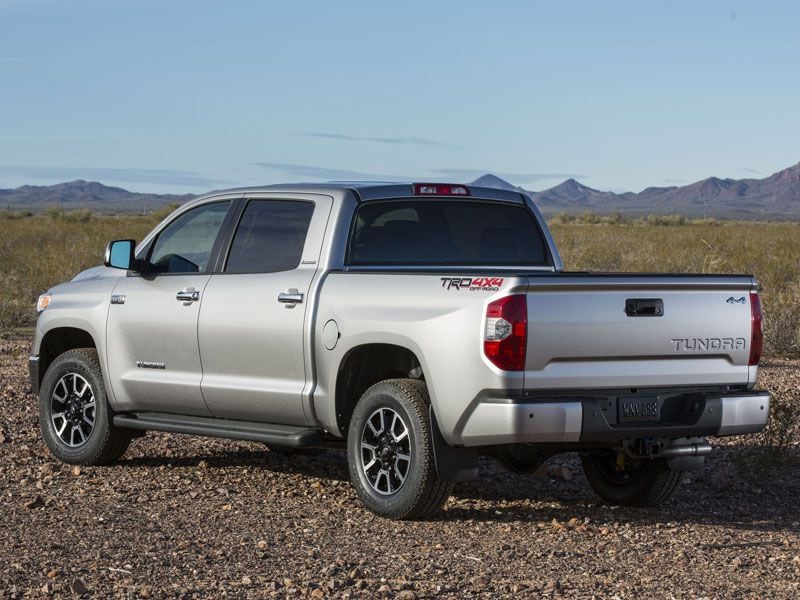
Photo by Toyota
2) The 2016 Toyota Tundra Offers Diversity
Toyota says the 2016 Tundra is offered in 50 different configurations. That’s not as many as the domestic competition, but is probably enough to satisfy most truck buyers most of the time.
Three cab styles are available: regular, extended (Double Cab), and crew (CrewMax). The base model is the SR, the popular model is the SR5, the upscale model is the Limited, and the luxury model is the Platinum. Toyota also offers a TRD Pro model designed for serious off-roading and a 1794 Edition model that upgrades the Platinum with unique design details.
Additionally, there are six different wheel designs, with availability contingent upon the trim level.
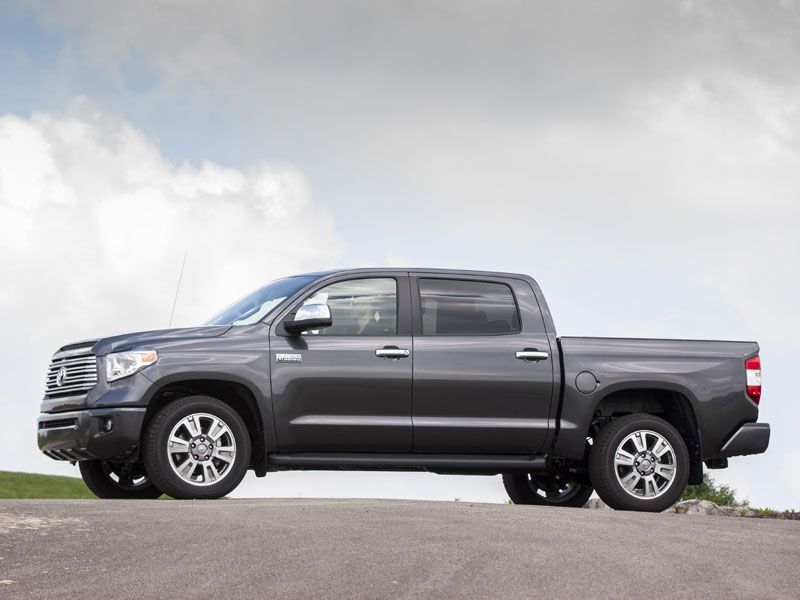
Photo by Toyota
3) The 2016 Toyota Tundra is Ready to Off-Road
Choose the Tundra SR5, Limited, or 1794 Edition, and a TRD Off-Road Package is available as an option. It adds special suspension tuning, skid plates for the engine and fuel tank, and unique 18-inch aluminum wheels with off-road tires.
For a more capable version of the Tundra, combined with a more aggressive look, consider the TRD Pro model. Identified by its special grille with large TOYOTA lettering, the TRD Pro boasts an aluminum front skid plate a quarter-inch thick, 18-inch wheels from Toyota Racing Development, 32-inch off-road tires, and a 2-inch front suspension lift for a Baja-style stance.
Additionally, the Tundra TRD Pro benefits from increased suspension travel, a TRD dual exhaust system, and special appearance changes inside and out. It is the only Tundra available in a color called Quicksand.
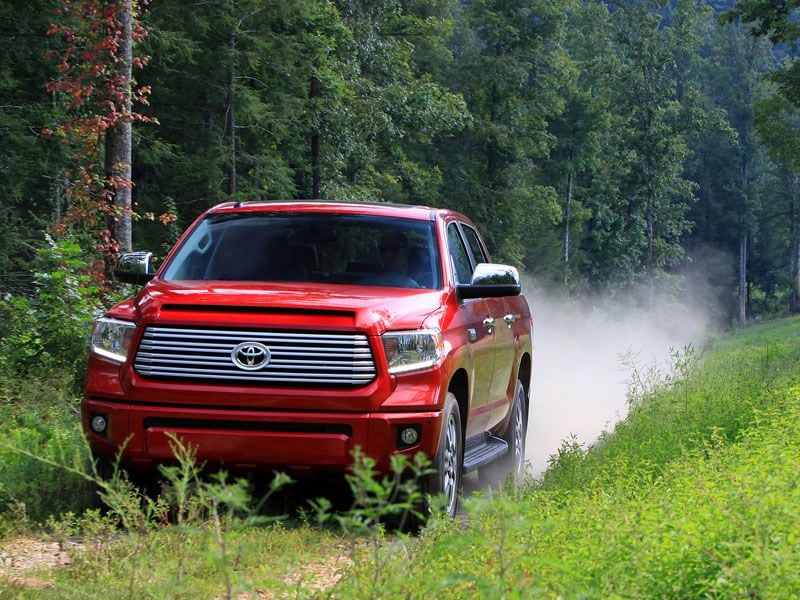
Photo by Toyota
4) The 2016 Toyota Tundra 1794 Edition is Steeped in History
Based on the ritzy Tundra Platinum model, the Tundra 1794 Edition is named for the Texas ranch land upon which Toyota built the Tundra factory. Located near San Antonio, the ranch dates to 1794. What makes this version of Tundra even more special is its Saddle Brown premium leather, extended-leather cabin treatment, and western lifestyle detailing.

Photo by Toyota
5) The 2016 Toyota Tundra Goes the Distance
For 2016, the Toyota Tundra gets a standard 38-gallon fuel tank, the company perfectly timing this change with the return of cheap gas.
Worst case, this means a Tundra with a 5.7-liter V8 engine and 4-wheel drive, which is rated to get 13 mpg in the city by the EPA, will travel a minimum of 494 miles.
Choose the smaller 4.6-liter V8, install it in a two-wheel-drive version of the Tundra, and cruise on the interstate where it is expected to get 19 mpg, and range jumps to 722 miles.
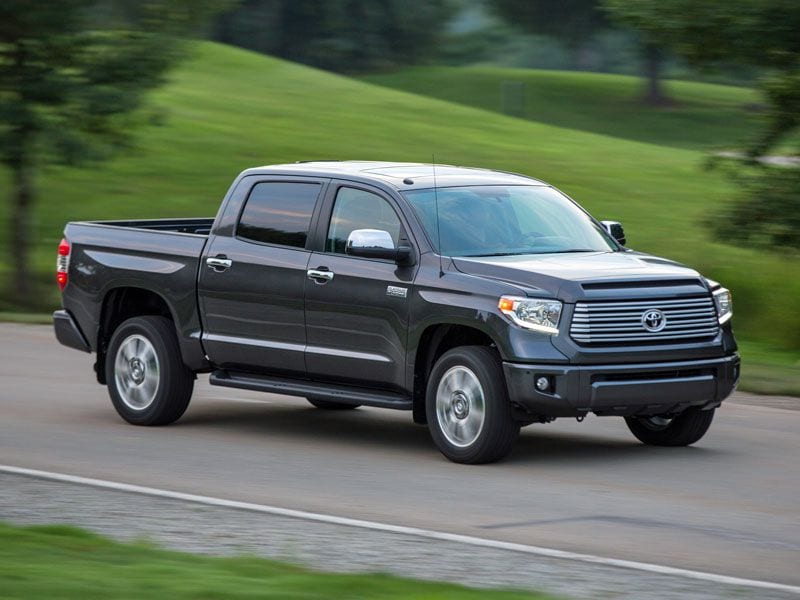
Photo by Toyota
6) The 2016 Toyota Tundra is V8-only
Every 2016 Tundra has a V8 engine. The smaller one displaces 4.6 liters, and is rated to make 310 horsepower at 5,600 rpm and 327 lb.-ft. of torque at 3,400 rpm. The larger one is a 5.7-liter V8 cranking out 381 horsepower at 5,600 rpm and 401 lb.-ft. of torque at 3,600 rpm.
A 6-speed automatic transmission feeds the power to the Tundra’s rear wheels, and a four-wheel-drive system is available. Toyota provides free scheduled maintenance for the first two years or 25,000 miles of ownership.

7) The 2016 Toyota Tundra Tows
There are two ways to look at the Toyota Tundra’s tow ratings. On the one hand, the truck’s maximum rating when equipped with the 5.7-liter V8 measures 10,500 pounds. That’s at least 1,500 lbs. short of the Chevy Silverado 1500, Ford F-150, and GMC Sierra 1500, but it comes close to the RAM 1500’s maximum rating of 10,800 lbs.
On the other hand, 22 different versions of the Tundra, across six different trim levels, can tow that much weight, perhaps giving truck buyers greater choice when it comes to tugging heavy loads.
When equipped with the 5.7-liter V8 engine, a Tow Package is standard for the Tundra. It includes a new integrated trailer brake controller for 2016, along with a one-piece tow receiver built into the truck’s frame and a Tow/Haul mode for the transmission. Heavy-duty electrical components, along with upgraded engine and transmission oil coolers, are also installed in all Tundras with a 5.7-liter V8.
As far as payload is concerned, the Tundra maxes out at 2,060 pounds, which is 180 lbs. more than a Ram 1500. The Chevy Silverado 1500 can manage up to 2,260 lbs. of weight in the bed, while the aluminum-bodied F-150 can tote as much as 3,270 lbs. of payload.

Photo by Toyota
8) The 2016 Toyota Tundra Makes Life Easier
If you’ve ever clambered aboard the Tundra CrewMax after missing an opportunity to call “shotgun,” you know this isn’t a bad thing, even if you’re stuck in the middle. That’s because the Tundra CrewMax’s rear seat is positively cavernous.
In addition to supplying lots of interior space, the Tundra has what Toyota calls a 3-piece bumper design that is claimed to make repairs easier. Most interior controls can be operated while wearing gloves, according to Toyota, and standard equipment includes a wiper de-icing system, heated side mirrors, mud guards, and adjustable cargo bed cleats. The locking tailgate also features an easy-lower-and-lift design, and can be removed if desired.
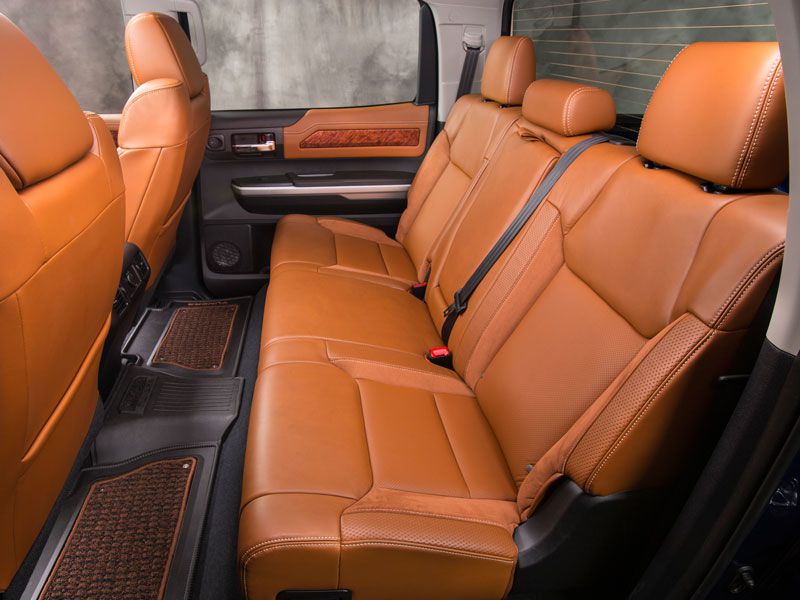
Photo by Toyota
9) The 2016 Toyota Tundra is Easier to Drive
Unquestionably, the Toyota Tundra is a big truck, and it feels like one from the driver’s seat. The expanse of dashboard is vast, and the size of the cabin dwarfs occupants. Thankfully, Toyota makes it easier to wield this big rig by including a standard reversing camera. Additionally, the Tundra Platinum and 1794 Edition models include a blind spot warning system, rear cross-traffic alert, and parking sensors for the front and rear bumpers. Each of these features can be added to the Tundra SR5 and Limited as an option.
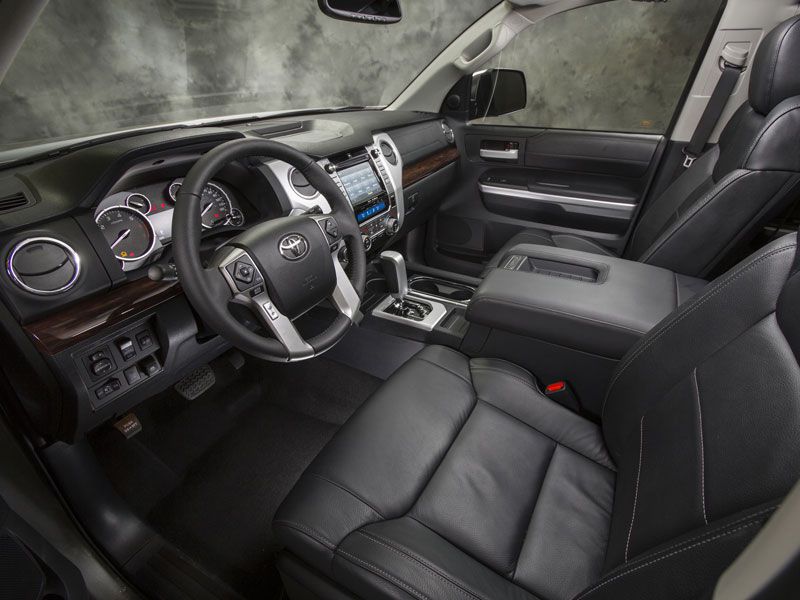
Photo by Toyota
10) The 2016 Toyota Tundra is Entertaining
Toyota introduced upgraded versions of its Entune infotainment systems this year. In the base Tundra SR, the system has a 6.1-inch touchscreen display as well as a quick-charge USB port, voice recognition technology with Siri Eyes Free capability, and Bluetooth with hands-free calling and music streaming.
Upgrade to the Tundra SR5 for a Scout navigation system that works when your smartphone is connected to the USB port. This version of Entune also comes with a larger 7-inch display screen, satellite radio, HD radio, iTunes song tagging capability, and HD traffic and weather reports.
Remaining Tundra models get a premium version of Entune, one equipped with a faster processor, an embedded navigation system, and App Suite technology. App Suite supplies access to supported applications including Internet search and Internet radio. Slacker radio support is new for 2016, and both the Platinum and 1794 Edition models are equipped with a JBL premium sound system.

Photo by Toyota